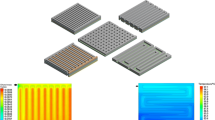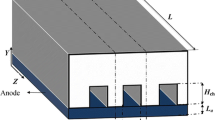Abstract
The dynamic operating behaviour of the direct methanol fuel cell (DMFC) is governed by several physico-chemical phenomena which occur simultaneously: double layer charging, electrode kinetics, mass transport inside the porous structures, reactant distributions in the anode and cathode flowbeds etc. Therefore it is essential to analyse the interactions of these phenomena in order to fully understand the DMFC. These phenomena were initially analysed independently by systematic experiments and model formulations. Electrode kinetics were determined by fitting models of varying complexity to electrochemical impedance spectroscopy (EIS) measurements. Reaction intermediates adsorbed on the catalyst seem to play a key role here. To describe mass transport across the DMFC a one-dimensional model was formulated applying the generalised Maxwell–Stefan equations for multi-component mass transport and a Flory–Huggins model for the activities of mobile species inside the membrane (PEM). Also swelling of the PEM as well as heat production and transport were considered. Finally, the anode flowbed was analysed by observing flow patterns in different flowbed designs and measuring residence time distributions (RTDs). Detailed CFD models as well as simpler CSTR network representations were used to compare to the experimental results. Even the simpler models showed good agreement with the experiments. After these investigations the results were combined: the electrode kinetics model was implemented in the mass transport model as well as in the CSTR network flowbed model. In both cases, good agreement, even to dynamic experiments, was obtained.









Similar content being viewed by others
Abbreviations
- c (mol m−3):
-
Molar concentration
- d (m):
-
Thickness
- i (mA cm−2):
-
Current density
- n (mol m−2 s−1):
-
Overall molar flux density
- r (mol m−3 s−1):
-
Reaction rate
- t (s):
-
Time
- T (K):
-
Temperature
- U (V):
-
Voltage
- z (m):
-
Cell coordinate perpendicular to cell plane
- Z (\({\Upomega}\)):
-
Impedance
- α (–):
-
Charge transfer coefficient
- η (V):
-
Overpotential
- \(\Uptheta\) (–):
-
Surface fraction
- ϕ (V):
-
Electrical potential
- AC:
-
Anode catalyst layer
- AF:
-
Anode feed
- CC:
-
Cathode catalyst layer
- M:
-
Membrane (PEM)
- a:
-
Anode
- c:
-
Cathode
- Cell:
-
Cell
- CH3OH:
-
Methanol
- CO:
-
Carbon monoxide
- Dead:
-
Due to experimental delays (“dead time”)
- H2O:
-
Water
- O:
-
Oxygen
- CFD:
-
Computational fluid dynamics
- CSTR:
-
Continuously stirred tank reactor (i.e. lumped parameter model)
- DMFC:
-
Direct methanol fuel cell
- EIS:
-
Electrochemical impedance spectroscopy
- PEM:
-
Polymer electrolyte membrane
- PEMFC:
-
Polymer electrolyte membrane fuel cell
- RTD:
-
Residence time distribution
- VCS:
-
Electrode kinetics model according to [4]
References
T. Schultz, Experimental and Model-based Analysis of the Steady-state and Dynamic Operating Behaviour of the Direct Methanol Fuel Cell (DMFC), Dissertation (Otto-von-Guericke University, Magdeburg, 2004). Free download: http://www.diglib.uni-magdeburg.de/Dissertationen/2004/thoschultz.htm
Schultz T., Zhou S., Sundmacher K. (2001). Binny. Chem. Eng. Technol. 24:1223
Carrette L., Friedrich K.A., Stimming U. (2001). Fuel Cells 1:5
Vidaković T., Christov M., Sundmacher K. (2005). J. Electroanal. Chem. 580:105
U. Krewer, System-oriented analysis of the dynamic behaviour of direct methanol fuel cells, Dissertation (Otto-von-Guericke University, Magdeburg, 2005). Free download: http://www.diglib.uni-magdeburg.de/Dissertationen/2005/ulrkrewer.htm
Kauranen P.S., Skou E., Munk J. (1996). J. Electroanal. Chem. 404:1
T. Vidaković, Kinetics of methanol electrooxidation on PtRu catalysts in a membrane electrode assembly, Dissertation (Otto-von-Guericke University, Magdeburg, 2005). Free download: http://www.diglib.uni-magdeburg.de/Dissertationen/2004/tanvidaković.htm
Sundmacher K. (1999). J. Appl. Electrochem. 29:919
Vidaković T., Christov M., Sundmacher K. (2004). Electrochim. Acta 49:2179
U. Krewer, M. Christov, T. Vidaković, and K. Sundmacher, J. Electroanal. Chem. 589 (2006) 148.
T. Schultz and K. Sundmacher, J. Power Sources accepted, 2006.
T. Schultz, K. Sundmacher, J. Power Sources 145 (2005) 435.
Schultz T., Sundmacher K. (2006). J. Memb. Sci. 276:272
Krewer U., Song Y., John V., Luebke R., Matthies G., Sundmacher K., Tobiska L. (2004). Chem. Eng. Sci. 59:119
U. Krewer, A. Kamat and K. Sundmacher, J. Electrochem. Soc. submitted.
M. Mangold, M. Grötsch and A. Kienle, J. Process Control, submited.
Author information
Authors and Affiliations
Corresponding author
Rights and permissions
About this article
Cite this article
Schultz, T., Krewer, U., Vidaković, T. et al. Systematic analysis of the direct methanol fuel cell. J Appl Electrochem 37, 111–119 (2007). https://doi.org/10.1007/s10800-006-9209-9
Received:
Revised:
Accepted:
Published:
Issue Date:
DOI: https://doi.org/10.1007/s10800-006-9209-9




